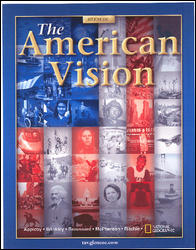

The American VisionChapter 6: Federalists and Republicans, 1789–1816Chapter OverviewsThis chapter follows the events that established the young United States as a strong federal government capable of withstanding the challenges of foreign conflicts, political dissonance, and westward expansion. Section 1 looks at how leaders of the United States established a central government. In 1789 the United States elected its first president, and Congress introduced the Bill of Rights. That same year, Congressional leaders organized the judicial branch of government and created a bureaucracy of departments that would serve the executive branch. President George Washington appointed Alexander Hamilton to head the Treasury Department and Thomas Jefferson to act as secretary of state. Hamilton's controversial financial program—which included taxation, a system of public credit, and a national bank—sparked regional divisions and even caused a rebellion. Washington's support of Hamilton's programs enhanced the powers of the federal government, but the debate over these issues split Congress into factions. As a result, the nation's first political parties emerged. The Federalists supported Hamilton's idea of a nation of big business and powerful government. Democrat-Republicans agreed with Jefferson's idea that the rights of the states' governments were supreme over the federal government. Section 2 describes the foreign policy challenges of the Washington and Adams presidencies. British seizures of American ships and reports of British aggression in the western territories led Washington to seek a treaty with Britain. Jay's Treaty avoided war, but it created political divisions in Congress. In Pickney's Treaty, Spain granted the United States the right to navigate the Mississippi and deposit goods at the port of New Orleans. As Americans flocked to the West, Native Americans in the Northwest formed confederacies to defend their land. When federal troops crushed their resistance, the Treaty of Greenville granted most of present-day Ohio and Indiana to the United States. Washington said farewell to public service, and Americans elected Federalist John Adams to the presidency. Adams' term was marked by a Quasi-War with France and political discord. Federalists exercised their muscle with the Alien and Sedition Acts, and Republicans countered with resolutions that supported states' rights. An unexpected outcome in the presidential election of 1800 gave the Republicans control and proved that the United States could transfer executive power peacefully. Section 3 follows President Thomas Jefferson's two terms in office. After two Federalist presidents, Jefferson brought his democratic views to the presidency. Hoping to limit the scope of federal power, he reduced the federal debt, cut government spending, and eliminated the whiskey tax. He attempted to cancel Federalist control of the federal courts, but an important decision by Supreme Court Justice John Marshall established the Supreme Court as a powerful, independent branch of the federal government. Jefferson's enthusiastic support of western expansion led to the Louisiana Purchase and expeditions that fueled Americans' interest in the newly acquired territories. During his second term, Jefferson tried to keep the United States out of the war between Britain and France. An unpopular embargo halted all trade between the United States and Europe and ended up paralyzing American industry. Congress repealed the embargo shortly before Jefferson left office. Section 4 describes how the War of 1812 gave Americans a strong sense of national pride. When Republican James Madison assumed the presidency, war with Britain was already on the horizon. Americans were angry over trade restrictions and British seizures of American ships and sailors. Some Western settlers blamed the British for inciting Native American attacks along the frontier. In Congress, War Hawks called for action, while northeastern leaders asked for restraint. Hoping to avoid war, both Madison and Congress tried strategies to force Britain to repeal its trade restrictions. A non-importation act against Britain finally worked, but not soon enough. In June 1812, the United States declared war on Britain. American forces tried to invade British-held Canada, but British troops successfully defended their territory. The British burned the White House and Capitol, but they failed to capture Baltimore and New Orleans. A treaty ended the war, and the United States emerged from battle with a new spirit of national unity. |  |















